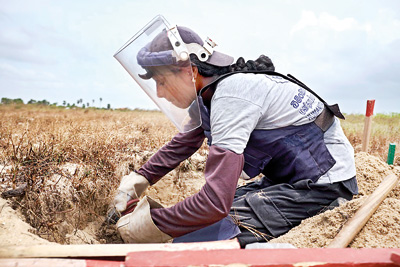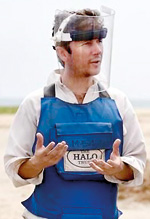Hope for a mine-free future
Damian O’Brien has worked in Somalia and the West Bank, but he’s never seen minefields quite like those in Sri Lanka. O’Brien is a Programme Manager with the HALO Trust, and has been based in the North of the island since April 2014. When he got here, his organisation was already neck deep in their biggest challenge, the clearing of the island’s largest minefields at Nagarkovil and Muhamalai.

A woman deminer at work. Pic by Devaka Seneviratne
“There are bigger minefields in other parts of the world, but those tend to be border minefields like the one between Mozambique and Zimbabwe; the border between Turkey and Syria is very heavily mined, as is the one between Israel and Jordan,” says O’Brien. These border defences stretch for many, many kilometres but Sri Lanka’s minefields are different, set apart by the very nature of the conflict that birthed them.
“What makes Sri Lanka quite remarkable is just how many mines there are in such a small area,” says O’Brien. “There aren’t really very many countries which have this sort of trench warfare for years on end.” He explains that as the Sri Lankan Army faced off against the LTTE, each victory or setback meant the (mine) lines were redrawn, with fighters laying down fresh stretches as a deterrent to enemy combatants.
Bent over a map, O’Brien traces the line of the A9 where it cuts through the minefield at Muhumalai. “We began working outwards from the road, and we did that because we didn’t know when we would have to stop, so we wanted to hand over a clearly defined area to the locals,” he explains. This uncertainty around mine-clearance efforts in Sri Lanka, even six years after the end of the war, is telling.
The HALO Trust has cleared nearly 200,000 mines since they began working here in 2002. However, the question of when the work will be complete is a difficult one to answer – so much depends not on those out in the field but on political will.
HALO has traditionally been the biggest demining operator in this country, with some 1100 people on their payroll as of 2014. (It is comprised overwhelmingly of locals – only two members of the staff are expatriates.)They are currently one of only a handful of demining organisations at work in Sri Lanka but even a few years ago there were more donors and more agencies including the Danish Demining Group (DDG) and the Swiss Foundation for Mine Action (FSD) who have since ceased operations in the country.

Damian O’ Brien
“In recent years as the diplomatic relationships between the previous government and donor governments deteriorated, the agencies found it a more challenging environment and the donors found they were less and less welcome,” explains O’Brien.
When former President Mahinda Rajapaksa’s government set a deadline of 2014 for these international agencies to leave the country, HALO’s biggest donors, the governments of the UK, US and Japan, found themselves unable to commit to much beyond that date. HALO’s employees were among those to feel the effects of that decision. “It meant that over the first six months of this year, I had to make 700 people redundant and that represented 50 per cent of the entire non-military capacity in the country across all agencies,” says O’Brien. “It was a huge loss and obviously that slows things down enormously.”
But the scenario has changed dramatically post-election. Since then the responsibility for demining has been passed from the Ministry of Economic Development to the Ministry of Resettlement, and fresh emphasis has been placed on returning the homes and lands of an estimated 30,000 IDPs. The return of Army and Navy held lands, including parts of the high security zones around Jaffna was unexpected, but very welcome news to the affected families, some of whom had been displaced from home for 25 years. “But now that the Army has released it, we are moving in to survey the area and clear some minefields there. That means that our workload, which has been diminishing over the years, has suddenly been added to at a time when we’ve lost a lot of capacity,” says O’Brien.
The good news though is the new government has said that there will be no more deadlines forcing agencies to exit the country, instead the focus is now on ensuring Sri Lanka is mine impact free by 2020. “That’s really good news and it’s working, existing donors are feeling very positive and they are recommitting,” says O’Brien.
If they can meet those targets, Sri Lanka will be a success story and a model for other countries facing similar challenges. Some of the technology deployed here, such as the innovative use of flail machines to survey and clear large areas quickly, have proven successful. This makes Sri Lanka a laboratory for manufacturers and humanitarian agencies looking at more efficient ways of approaching the otherwise laborious and time consuming task of demining.
There is too, to the country’s credit, the structures that allowed government and donor agencies to coordinate their work, and share their learning, as well as the ease with which staff were trained both here and abroad. “Sri Lanka’s success comes down to effective cooperation, coordination and clarity of purpose,” says O’Brien.
For him the rewards are seeing citizens reclaim their homes and their lands. “The mining had a devastating impact,” he says pointing to how it could arrest the economic regeneration of affected areas. Those who were caught in accidents were often on the economic margins of society, with very little in the way of a financial buffer to enable them to weather disability, loss of livelihoods and medical costs.
“It is traumatic in itself, to be somewhere where these accidents happen,” says O’Brien now, pointing out that in the long run the very existence of these minefields delays psychological and emotional recovery from the conflict. When they are cleared though, families return, communities are rebuilt and normalcy is quickly restored. Schools, clinics, shops and homes have been built on the lands cleared by the demining agencies. “It’s important that we do this work and that we do it properly the first time,” says O’Brien, “that way people can forget there was ever a minefield there.”


